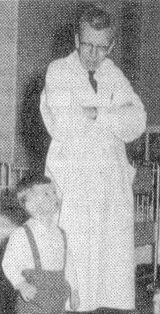(tidy) |
No edit summary |
||
| Line 47: | Line 47: | ||
| ⚫ | |||
| ⚫ | |||
| ⚫ | |||
[[de:Hans Asperger]] |
[[de:Hans Asperger]] |
||
[[es:Hans Asperger]] |
[[es:Hans Asperger]] |
||
| Line 59: | Line 56: | ||
[[pt:Hans Asperger]] |
[[pt:Hans Asperger]] |
||
[[fi:Hans Asperger]] |
[[fi:Hans Asperger]] |
||
| − | [[sv:Hans Asperger]] |
+ | [[sv:Hans Asperger]].. |
| ⚫ | |||
| ⚫ | |||
| ⚫ | |||
Revision as of 01:04, 11 October 2012
Assessment |
Biopsychology |
Comparative |
Cognitive |
Developmental |
Language |
Individual differences |
Personality |
Philosophy |
Social |
Methods |
Statistics |
Clinical |
Educational |
Industrial |
Professional items |
World psychology |
Clinical: Approaches · Group therapy · Techniques · Types of problem · Areas of specialism · Taxonomies · Therapeutic issues · Modes of delivery · Model translation project · Personal experiences ·

Hans Asperger, who discovered Asperger Syndrome, described his patients as "little professors".
Hans Asperger (February 18, 1906 – October 21, 1980) was the Austrian pediatrician after whom Asperger's Syndrome is named.
Life
Born on a farm outside Vienna, Asperger displayed an early talent for languages. He was a member in the youth movements of the 1920's. He took his medical doctorate in 1931, and found his first job a year later as a member of the university children's clinic. In 1934 his career developed with a move to psychiatric hospital in Leipzig.
It is not certain what he did during the early years of World War II. In the later years of the war he was a soldier in Croatia. In 1944, after the publication of his paper, he found a permanent tenured post at the University of Vienna. Shortly after the war ended he became director of a children's clinic in the city. He later held posts at both Innsbruck and Vienna, then from 1964 he headed the SOS Children's Villages in Hinterbrühl. During his life, he published over 350 medical papers.
Asperger's Syndrome
Asperger published the first definition of Asperger's Syndrome in 1944. In four boys, he identified a pattern of behavior and abilities that he called "autistic psychopathy," meaning autism (self) and psychopathy (personality disease). The pattern included "a lack of empathy, little ability to form friendships, one-sided conversation, intense absorption in a special interest, and clumsy movements." Asperger called children with AS "little professors" because of their ability to talk about their favourite subject in great detail. It is commonly said that the paper was based on only four boys. However, Dr. Günter Krämer, of Zürich, who knew Asperger, states that it "was based on investigations of more than 400 children".
He was convinced that many would use their special talents in adulthood. He followed one child, Fritz V., into adulthood. V. became a professor of astronomy and solved an error in Newton’s work he originally noticed as a child. Hans Asperger’s positive outlook contrasts strikingly with Leo Kanner's description of autism, of which Asperger's is often considered to be a high functioning form.
Near the end of the World War II, Hans Asperger opened a school for children with autistic psychopathy, with Sister Victorine. Sadly the school was bombed towards the end of the war, Sister Victorine was killed, the school was destroyed and much of Hans Asperger's early work was lost. It was this event that arguably delayed the understanding of autism spectrum conditions in the west.
Interestingly, as a child, Hans Asperger appears to have exhibited features of the very condition named after him. He was described as a remote and lonely child, who had difficulty making friends. He was talented in language; in particular he was interested in the Austrian poet Franz Grillparzer whose poetry he would frequently quote to his uninterested classmates.
Asperger died before his identification of this pattern of behaviour became widely recognized because his work was mostly in German and little-translated. The first person to use the term "Asperger's Syndrome" in a paper was British researcher Lorna Wing. Her paper, Asperger's syndrome: a clinical account, was published in 1981 and challenged the previously accepted model of autism presented by Leo Kanner in 1943. Unlike Kanner, his findings were ignored and disregarded in the English speaking world in his lifetime. His clinic was bombed during the war as well. Finally from the early 1990's, his findings began to gain notice and nowadays Asperger's Syndrome is a recognised world-wide condition.
International Asperger's Year, 2006, marks the 100th anniversary of Dr. Asperger's birth and the 25th anniversary of Dr. Wing's landmark paper. International Asperger's Year was conceived by the Asperger Adults of Greater Washington.
See also
- Asperger Syndrome
- List of Austrian scientists
- Refrigerator mother
Papers
- Asperger, H. (1944), Die 'Autistischen Psychopathen' im Kindesalter, Archiv fur Psychiatrie und Nervenkrankheiten, 117, pp.76-136.
- Asperger, H. (1968), Zur Differentialdiagnose des Kindlichen Autismus, Acta paedopsychiatrica, 35, pp.136-145.
- Asperger, H. (1979), Problems of Infantile Autism, Communication, 13, pp.45-52.
Further reading
- Frith, U, (1991)(ed.) Autism and Asperger Syndrome (Cambridge University Press, ISBN 0-521-38608-X) — in which Asperger's 1944 paper is translated and annotated
- Frith, U. (1991). Asperger and his syndrome. In U. Frith (Ed.), Autism and Asperger Syndrome. (pp. 1-36). Cambridge: Cambridge University Press.Full text
External links
- Asperger's syndrome: a clinical account — abstract
- International Asperger's Year listserv
- Online Asperger Syndrome Information & Support
de:Hans Asperger
es:Hans Asperger
fr:Hans Asperger
nl:Hans Asperger
no:Hans Asperger
pt:Hans Asperger
fi:Hans Asperger
sv:Hans Asperger..